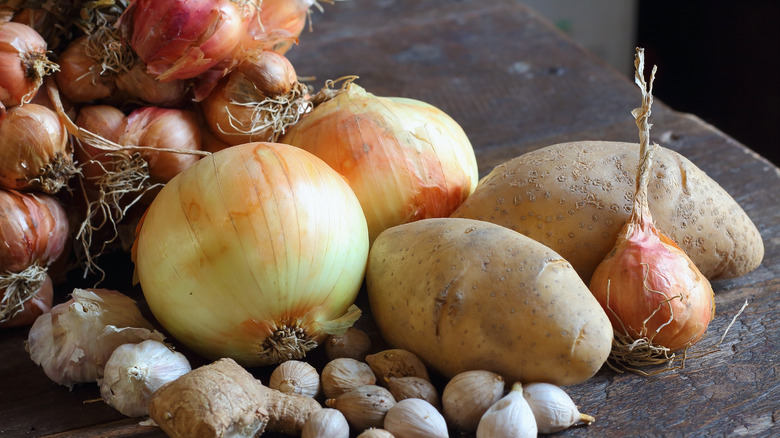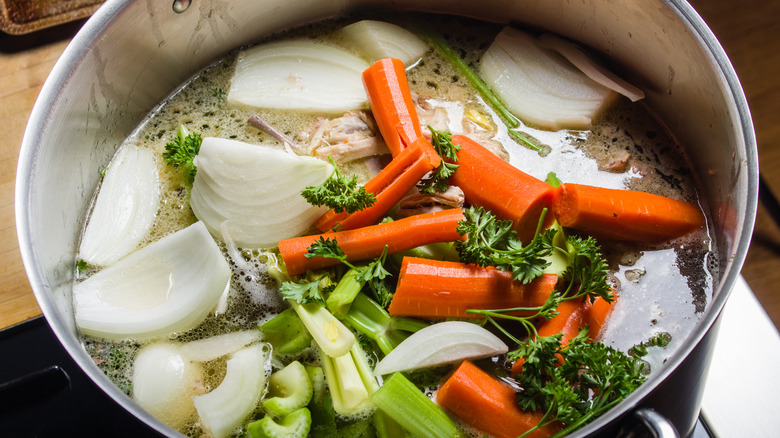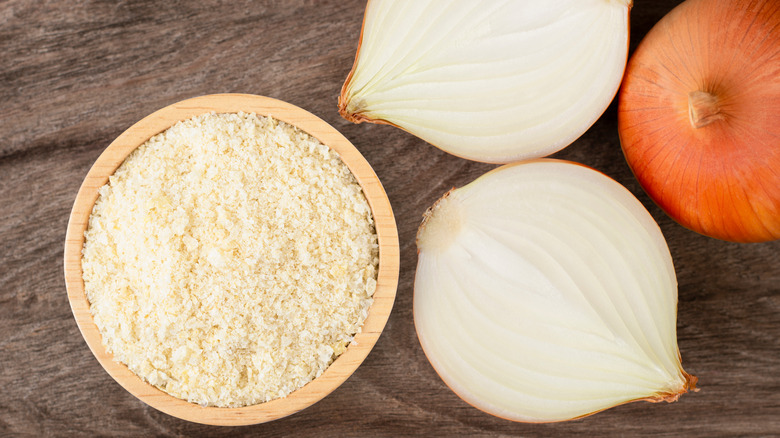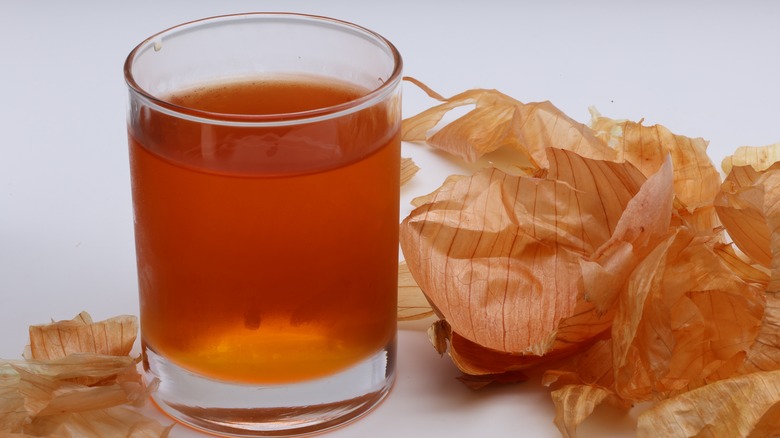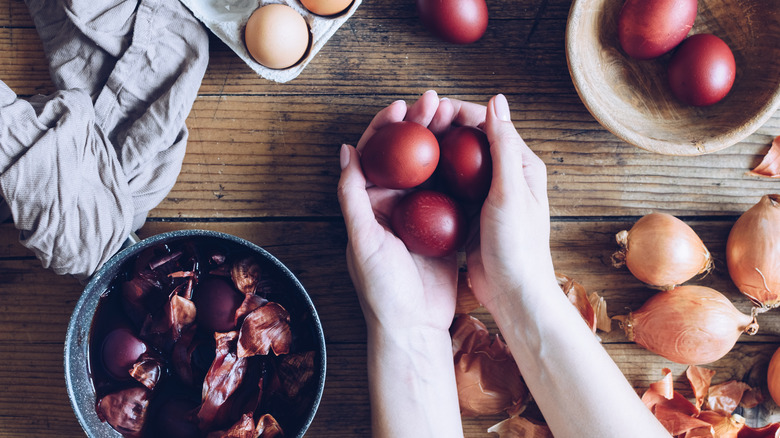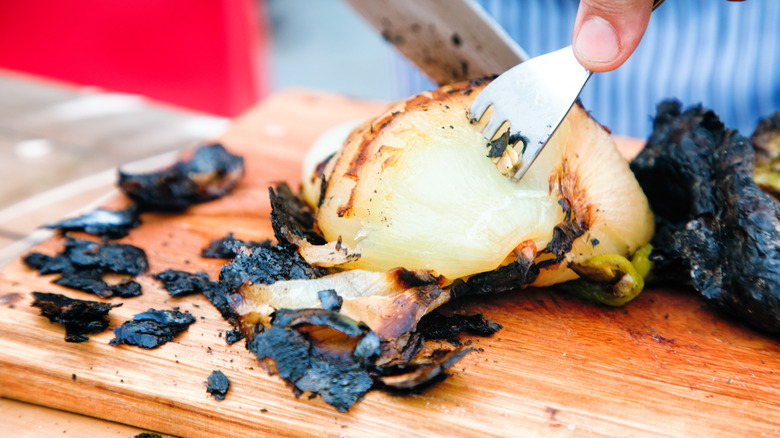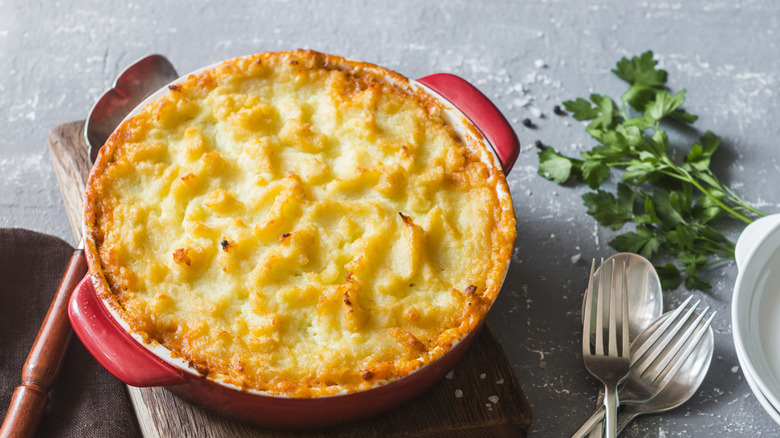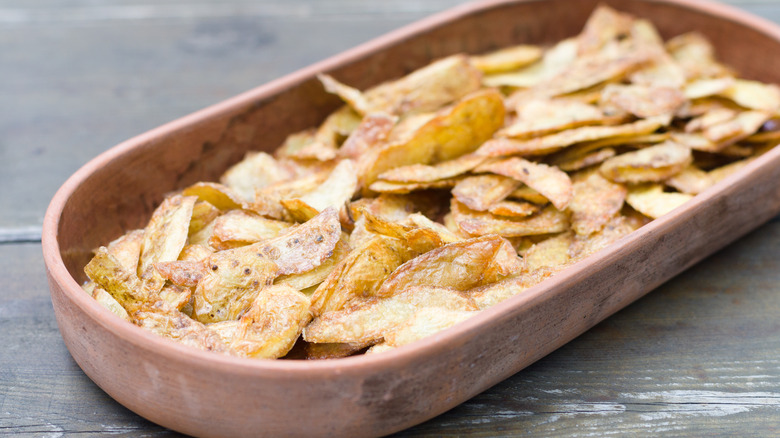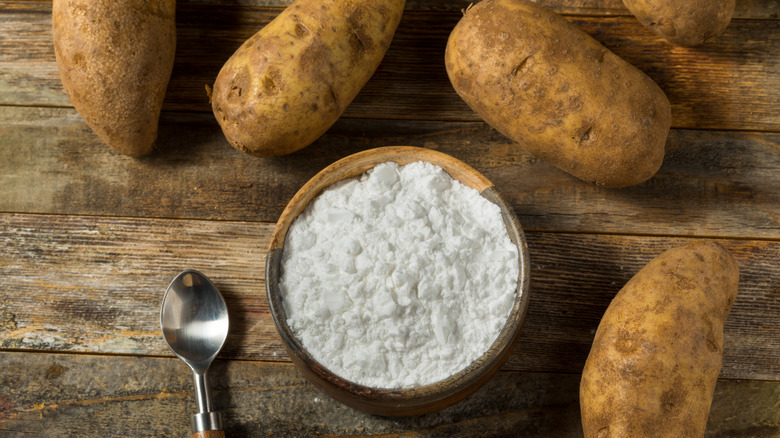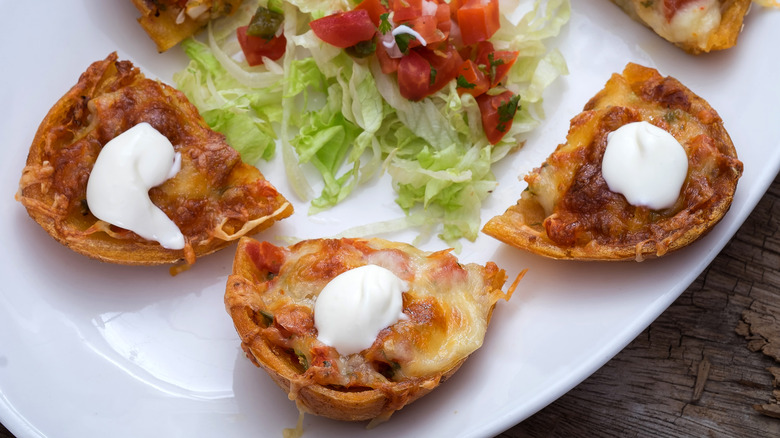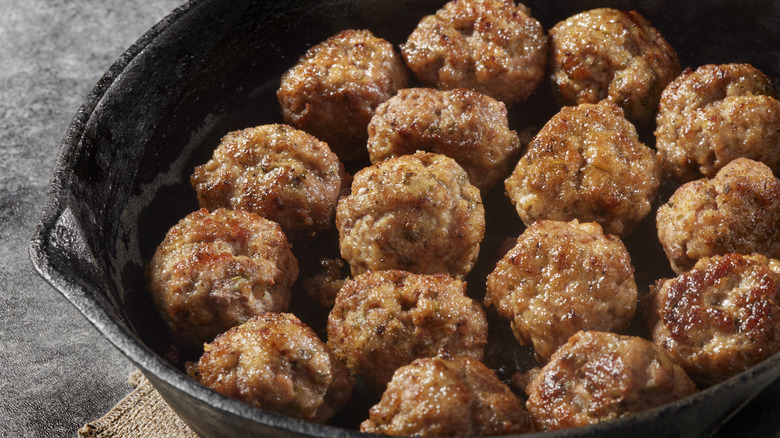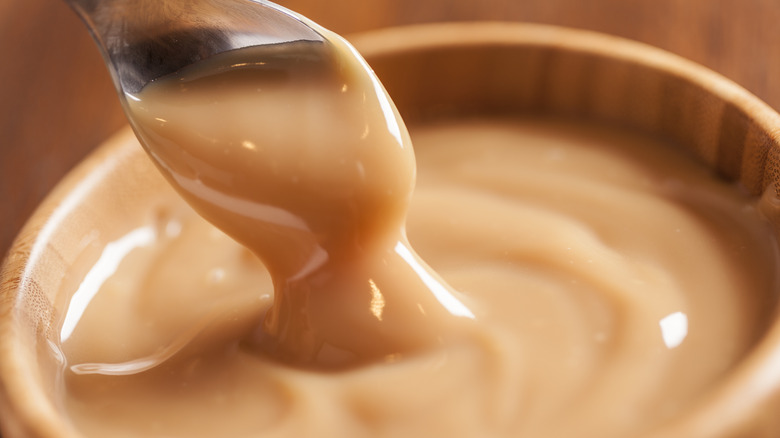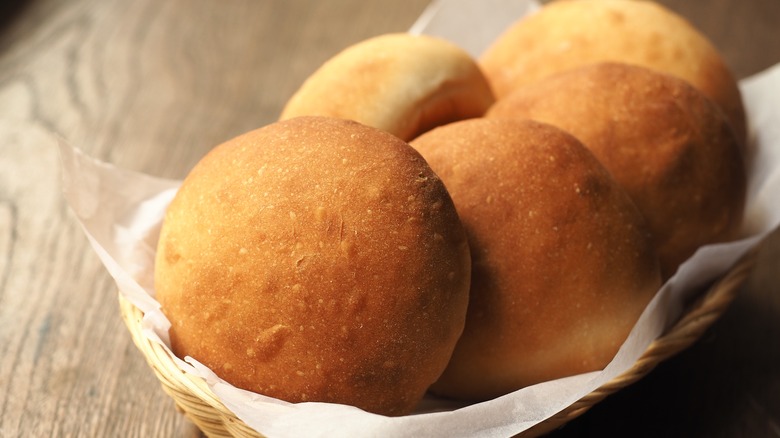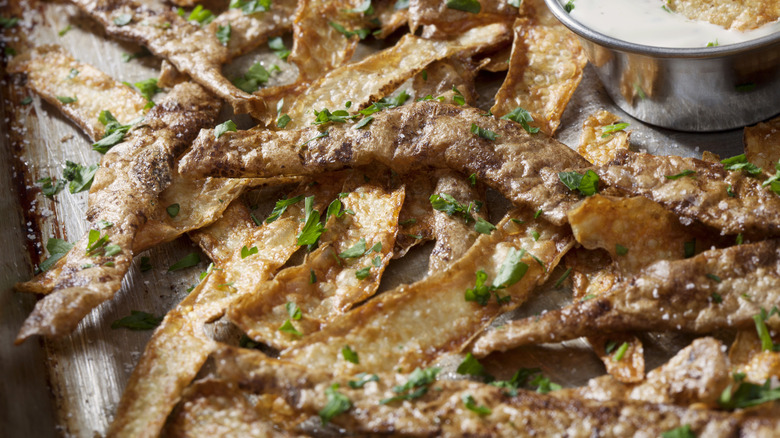The Absolute Best Uses For Potato And Onion Peels
If you've ever had to make French onion soup or even a jumbo batch of caramelized onions, you've probably thrown away hundreds of dry onion skins without a second thought. The same thing probably happens when you make a sheet pan of garlic roasted potatoes or mashed potatoes, with potato peels overflowing in the trash can or banished to the compost pile. But each one of those discarded peels represents a missed opportunity for a chef's creativity to shine.
Luckily, giving new life to your food scraps has never been a tastier or easier endeavor, especially with a bit of ingenuity on your side. Here, we tackle all the ways you can use both your onion and potato peels to your advantage in the kitchen, from brewing antioxidant-rich tea to pumping up the volume of your favorite bread recipe. Break out the vegetable peelers and grab a zip-top bag — it's time to turn your scraps into stars.
Pump up the allium flavor in stocks
You may already be aware that onions provide an invaluable savory flavor to your stocks, but did you know that the peels are just as flavor-enhancing? Domestic goddess Nigella Lawson makes soup stock by tossing her onions with the skin still intact. The skins contain a nice subtle allium flavor and will perfume the soup with its delicate flavor. Even if the flavor is too mild for you to notice, the natural onion dye will add a gorgeous hue to your stock, continuing to make it a worthy addition.
To try this tip out, save your onion skins by freezing them in a Ziploc bag and adding them to your stocks whenever you're making your next batch. Better yet, take this hack one step further by saving your garlic and onion peels. Make sure that you're adding your onion peels to stock recipes, not plain soup recipes that don't require you to strain out the solids. Otherwise, you'll have onion skins floating around in your soup.
Make your own onion skin powder
As one of the most versatile pantry spices, onion powder is incredibly easy to make with onion peels. You can make it one of two ways. First, thoroughly wash your onion skins and dry them with a dehydrator or slow roast them in an oven at 150 degrees Fahrenheit for roughly 3 hours. After being dehydrated, you can then grind your onion skins in a blender or coffee grinder to be transformed into a homemade onion powder. One important note: Make sure you're using organic onions that haven't been sprayed with pesticides, as the outer layers of that peel can be dangerous to consume.
Once you've made this powder, the sky's the limit on what you can add it to. First, try to incorporate subtle onion flavor to bread dishes, like Irish soda bread or buttery Parker House rolls. Next, think about what a rich onion powder rub would do to your pork shoulder roast. Alternatively, try spiking a cheesy recipe, like decadent mac 'n cheese, to really see it shine.
Brew some onion peel tea
Onion in your tea? Don't knock it 'til you try it. Onion peel tea, also known as Pyaaz Chaa, has long been used as a flu and cold remedy in India, while those in the Dominican Republic make red onion tea as an immune boost and to cure the common cold. But recent research has shown that onion peel-infused tea could have even more health benefits. A study published in the Journal of Cancer Prevention has shown that quercetin, an antioxidant found in onion peels, can help fight obesity and bad cholesterol.
So how should you go about brewing your own quercetin-rich cup? First, clean your onion skin scraps thoroughly, and make sure you're using organic onions. Simmer them in water for about 10 to 15 minutes. A good rule of thumb is to use 1 cup of water for every onion you use. As for choosing which onions to use, onion skin tea is often made with the peels of red onions, as red onion has a particularly high dose of quercetin, but any allium will work well. Other things like honey, ginger, and even a bit of green tea can be added for flavor.
Use onion skin as a natural dye
Strangely enough, that very same antioxidant that makes your onion peel tea so healthy, quercetin, is the reason you can use onion peels as a natural dye. In Turkey, onions have long been used as a natural dye for carpets and rugs, imparting brown, yellow, and red hues to the fabric. Similarly, Native Americans like the Iroquois and Great Basin tribes would use onions to dye their cotton deep brown, golden, and even green. So how can you bring this ancient art into your kitchen?
One popular use for onion dye is to paint hard-boiled eggs for Easter. Yellow onion skins make the white eggs turn a red-brown russet color, while red onion skins can tint the eggs a bit more purple-red. You simply boil the eggs and onion skins together in a water bath with 200 milliliters (about 13 tablespoons) of red wine vinegar because it helps the shells absorb the color. Allow the eggs to soak in this dye water for an extended period of time (about 30 minutes). Keep in mind, the more onion skins you use, the richer the color will be. This hack can also be applied to cotton and silk dying as well. Plus, onion skin will even help dye your soup stocks, giving them a more appetizing, deep golden color.
Char it for DIY onion skin ash
Vegetable ash can be its own masterpiece, so why not make your own with those leftover onion skins? Stick them under the broiler until they're properly charred. Once the peels have cooled, simply give them a chop in the blender until they resemble black dust. Pro tip: Cast-off cleaned leek layers are particularly easy to convert into this umami-rich powder.
A good use for this homemade powder is to mix it with some quality butter to make a burnt onion compote butter perfect for slathering on dinner rolls or for basting fresh-from-the-grill steaks. An even simpler way to enjoy it is by sprinkling it directly onto whatever dish you choose, from a rich potato gratin to a citrus-poached salmon. Or, bring it to your home bar and pair it with some salt to make a divine smoky Bloody Mary salt rim. Once you unlock its potential, you'll treat it like culinary fairy dust.
Try retro potato peel pie
Made famous by the book and subsequent Netflix film, "The Guernsey Literary and Potato Peel Pie Society," the eponymous Potato Peel Pie was a recipe born of strict rationing in German occupied Guernsey. According to the BBC, food shortages during World War II contributed to the use of fried potato peels, amongst other things. Cooks who lacked access to flour and butter made pies with the local vegetables they had on hand, using the potato peels as a makeshift crust and mashed potato and beetroot as the filling. While it was born of necessity, it can be brought into the 21st century with a few adaptations. First, you can use tangy pickled beets to add a hint of acid to the mix. Leeks, cheese, and cream can help further transform this pie into a modern star.
Alternatively, you can take the best idea from this recipe — using potato peels as a pie crust — and use it in other classic recipes. Imagine the crispy appeal of a potato skin-crusted chicken pot pie or an enchilada pie. It can also work as a crust for your favorite frittata recipe, giving it a Spanish omelette flair. The only thing to keep in mind is that the potatoes will shrink in the high heat, so be overly generous in laying the potato ground work for your pie crust.
Air fry potato peel chips
If you have an air fryer and plenty of potato skins, you're halfway home to creating one of the better, healthier snacks out there. Some potato skins can have up to 12 times more antioxidants than their potato flesh counterparts. Potato skins are also rich in potassium and magnesium. Plus, if you use your air fryer, you'll be cutting down significantly on the amount of fat needed to crispy up your fries. So how should you go about transforming your peels into air fryer chips?
Start with collecting and cleaning peels from at around five to six potatoes. After you've thoroughly rinsed and patted them dry, pop them in your handy air fryer to fry until appropriately crackly. If you want to keep it expertly crisp, make sure to avoid these air fryer mistakes and don't overcrowd the basket when layering in your potato skins. Add chopped herbs, seasoning blends, and infused oil (like rosemary or truffle oil) to the chips to give them a more luxe flavor.
Blitz homemade potato starch
Yes, you can turn leftover potato peels into a perfect thickener or powder. First, rinse and pat dry your potato peels to make sure all dirt or impurities are washed away. Next, use either a dehydrator to dry out the peels or set your oven to 225 degrees Fahrenheit and slow roast the potato peels for two to four hours. Either way, you'll take your dried out potato peels and give them a thorough chop in the food processor or blender until you have a nice, fine powder.
What should you use it for? The best use for your homemade potato peel powder is to thicken soups and sauces as well as use it in gluten-free baked goods. This bit of potato powder will also work in helping thicken and set the fillings of your chicken pot pie. Similarly, you can use this potato powder to coat chicken to create perfect Japanese fried chicken. However you need it to improve the texture of your cooking, this DIY potato powder will fit the bill.
Transform the peels into potato nachos
If you recently baked some Russet potatoes to elevate your mashed potatoes, we have the perfect use for those leftover skins. Those thick, sturdy potato peels work wonderfully as a crispy, starchy alternative to tortilla chips in this nacho hack. Think of it like a Tex-Mex twist on stuffed potatoes, with ground beef, cheese, salsa, and avocado replacing the typical filling.
To recreate this idea, start with large, thick potato skins, like those you can find from Russet potatoes, as they'll crisp up the best and hold the toppings well. Others can be used in a pinch, but you might find the thinner potato skins to be too flimsy. Much like with a typical loaded potato skin recipe, you'll want to roast and crisp up the skins separately, coating them with olive oil and salt before roasting at 450 degrees Fahrenheit for about 10 minutes per side. Once that's done, you can begin loading them up with your favorite nacho toppings. Remember, the best part about this tip is that it allows for more toppings-to-chip ratio — the best of all worlds.
Use potato peels as a starchy breadcrumb substitute
Looking to add a little dimension to your next batch of meatballs or meatloaf? Why not make your own starchy, hearty breadcrumb substitute by using potato peels? In addition to working as a stereotypical binder, the potato breadcrumbs add heft to the overall recipe and help bring a welcome boost of moisture to the meat mix.
To transform your potato peels into a crumbly mixture, pulse them briefly in the food processor. You want to have a light hand when processing, as if you pulse it too much, you'll turn your crumb mixture into a paste. Instead, shoot for a chunky, oatmeal-like appearance. Add a bit of salt to your potato meal, as the starch will need a bit more than your standard breadcrumbs. From there, you can use this makeshift breadcrumb meal in meatballs, meatloaf, or any other meat options. This works particularly well with recipes that use pork, as the rich fat content helps crisp up the potato that is exposed on the surface.
Make potato milk jam
Potato peels can help give a classic condiment a starchy makeover as a fun twist on the dulce de leche. Dulce de leche, a popular Latin American treat, is also known as milk jam, and can be made with sweetened milk, sugar, and your trusty discarded potato peels. Boiled together, they make a sticky, caramel-like condiment perfect for slathering on toast or dolloping on ice cream.
To make your own batch, salt, oil, and roast your potato skins first. This gives your potato a rich caramelized flavor and removes excess moisture. Next, you'll simmer whole milk, sugar, and the roasted potato peels for roughly two hours, stirring every 15 minutes to keep it from burning. By the end, your mixture should have the consistency of honey with a golden hue. From there, you'll strain out the potato skins and serve. If you want add an extra sweet touch, consider adding in a vanilla bean seed and its pod to the simmered milk mixture to infuse it with that floral flavor. Alternatively, you can stir in a teaspoon of vanilla extract after cooking for similar results.
Add potato peels to your bread for fluffy results
Many bakers know that potato flakes is the secret ingredient that can help make bread even more tender. This trick lies in the high level of starch in a potato, as starch absorbs and holds moisture well, keeping bread tender for an extended period of time. Though you can use the aforementioned potato flakes or mash to incorporate some starch into your bread, potato peels work just as well, especially in savory loaves like focaccia or potato buns.
First, boil your potato peels until it's fork tender. Once they've cooled, send them to the food processor; the smoother, the better for the texture of your bread. You can add about ¼ cup of potato peel mash for every cup of flour to help plump up the crumb. Alternatively, consider using your homemade potato powder mentioned in a previous slide as it works much like potato flakes.
Make a crunchy soup garnish
If the reason you have a surplus of potato skins is because you just made a decadent potato chowder, this hack is made for you. In this case, you can add textural dimension to your creamy soup by creating a perfectly crunchy soup garnish from those cast-off potato skins. Even if the soup in question isn't potato-centric, a potato skin chip garnish would work wonders in a cream of mushroom soup, spicy, beefy chili stew, or a chilled, veggie-forward gazpacho.
To create your garnish, you could use an air fryer to make chips, or you can use your oven to roast them to crispy perfection. If you do go the oven route, remember to roast them at a high temperature (at least 400 degrees Fahrenheit) and properly coat them in oil so that it can get as crunchy as possible. For seasoning, you can keep it simple and just sprinkle it with salt, or add a bit of spice and coat it in some smoked paprika. Don't consign this trick to regular potato peels either; sweet potato peels would be delicious in this incarnation as well.
